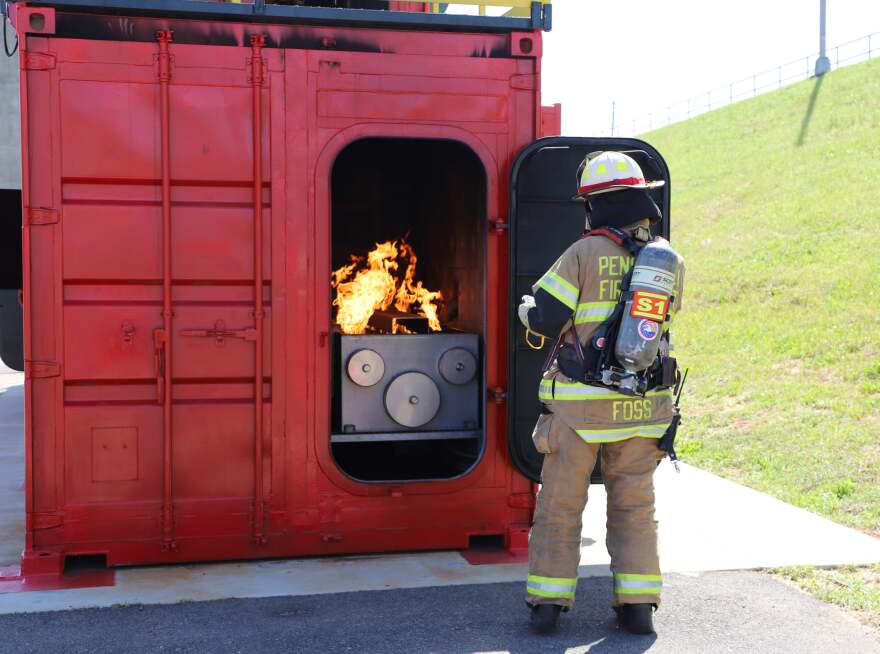Pensacola-area residents are expected to get a break on their home fire insurance, thanks to a new tool at the city’s training facility for firefighters.
“There’s a phrase that, ‘Good firefighters are made on the fire ground or on the emergency scenes.’ But really, what’s more, true is great firefighters are made at a place just like this. Made on the drill grounds because experience is what you get after you needed it, right?” said Pensacola Fire Chief Ginny Cranor, standing in front of the maritime fire training simulator at the department’s training facility on Q Street.
Comprised of three shipping containers arranged in a three-story configuration similar to a tugboat, it includes two styles of marine bulkhead doors. Training on it, said Cranor, will begin with coordinated tours of an actual ship at the Port of Pensacola and elsewhere.
“We look at the layouts; how many people are aboard the ship [and] what are their escape paths?” she said. “What special fire safety enhancements does the ship have? And we look at securing fuels and batteries, and special processes. And then we apply what we’ve learned on a simulator like this — under live-fire real conditions.”
As the only ship simulator in the region, it will train firefighters, law enforcement, paramedics, and others from departments stretching from Panama City to Mobile. Before becoming chief, Cranor worked on the grant that enabled the department to build the maritime simulator.
“Less than $400,000, largely funded by FEMA grants through the Port Security Grant Program,” Cranor said. “But also through Local Option Sales Tax funds that were allocated by the [Pensacola city] council and prioritized by the mayor and his staff.”
An added benefit of the trainer is boosting Pensacola’s Insurance Services Office — or ISO — fire rating. As of June 1, the PFD becomes a Class-1 ISO fire department. Several factors, says the chief, are involved.
“The largest part of it is what Pensacola Fire’s doing every day — response to fires, drills, and training, pre-fire planning activities, fire safety inspections, construction plans review, and then also the apparatus and equipment that we have.”
“Less than one percent of all the communities in the United States have a one [ISO score], and we are very thankful to have a team that does such a great job. They prepare, they train, they take care of us every day,” said Mayor Grover Robinson, who held his weekly news conference at the training center. He added that the ISO score gauges how prepared a community or area is for fires.

“A strong ISO score suggests to insurance providers that the likelihood of being destroyed by a fire is low, than if you lived in a poor ISO score area,” the mayor said. “A strong ISO score reduces property insurance costs, compared with a community that does not achieve as strong of an ISO.”
And in case anybody’s wondering, Fire Chief Ginny Cranor says shipboard firefighting is different from fighting a blaze at a land structure — starting with the materials involved.
“The materials, the construction, the rate of heat release of materials that are burning, and the best extinguishing practices; those are all different factors,” she said. “This is gas-fired, which is cleaner in a lot of ways, for our firefighters to be able to use that.”
Many vessel fires occur when they’re in port or at some other local harbors, says the chief. Some situations arise for such tactics, so the new trainer will come in handy.
“And also, it is multifunctional,” said Cranor. “So we can also take the type of fire we can create in this building, and we can also use it as if it was a fire inside of a building, and just use our imagination and training to set up different types of drills and scenarios.”
One asset missing from the city’s fire-protection lineup is the fireboat, which was christened in 2014, and is now back at its manufacturer in Canada. Cranor says it’s a victim of the COVID-19 pandemic.
“It is getting some grant-funded manufacturer upgrades — special chemical, biological, radiological, type of upgrades that had to be done by the manufacturer,” Cranor said. “And because of the pandemic, it’s been in Canada for a little while. We’re still working on sea trials before we can have the boat returned.”
The Maritime Fire Training Simulator Features three simulators and a smoke generator to set up drills in fighting fires in a galley, engine room with flashover, and bilge fire. Using the propane, interior temperatures can reach in excess of 400 degrees Fahrenheit.

